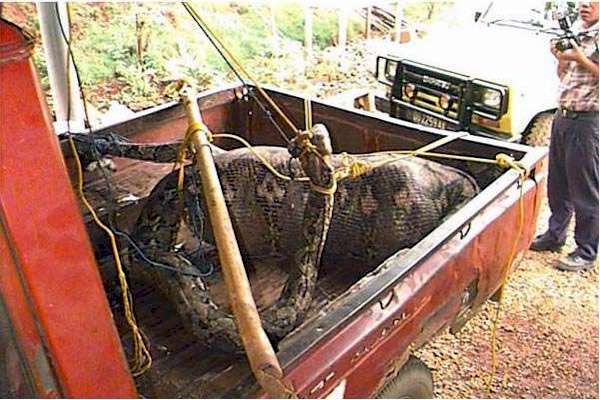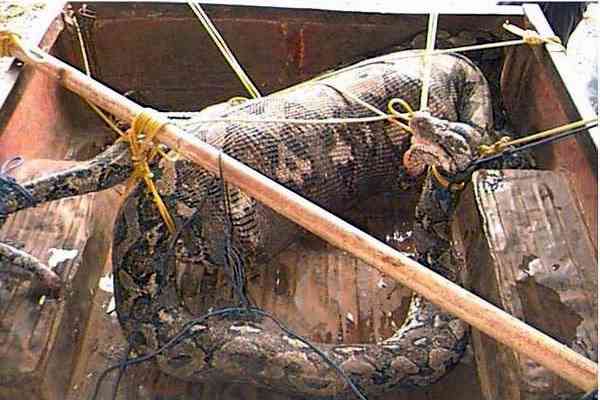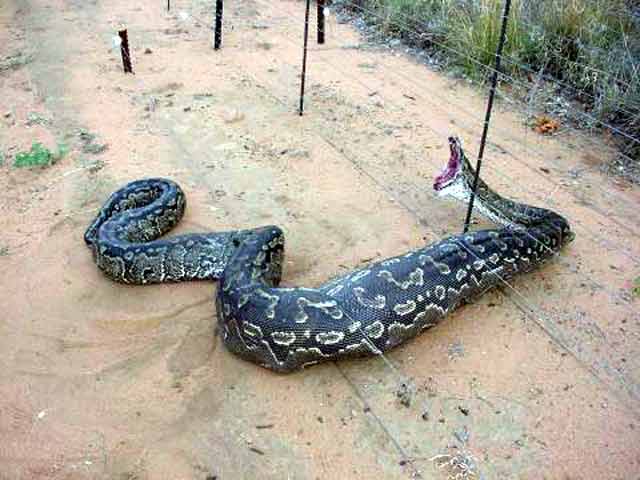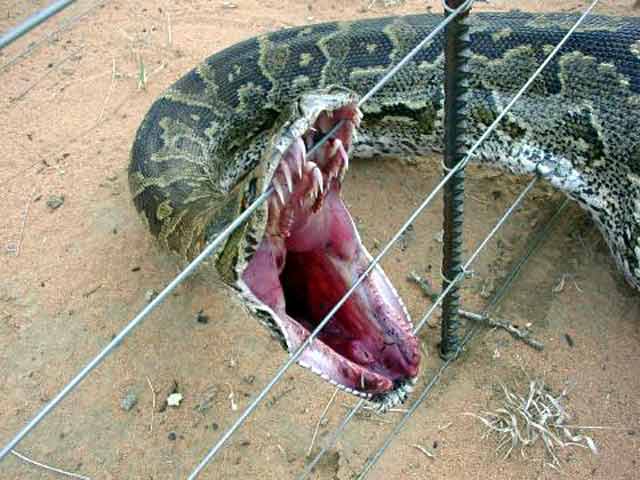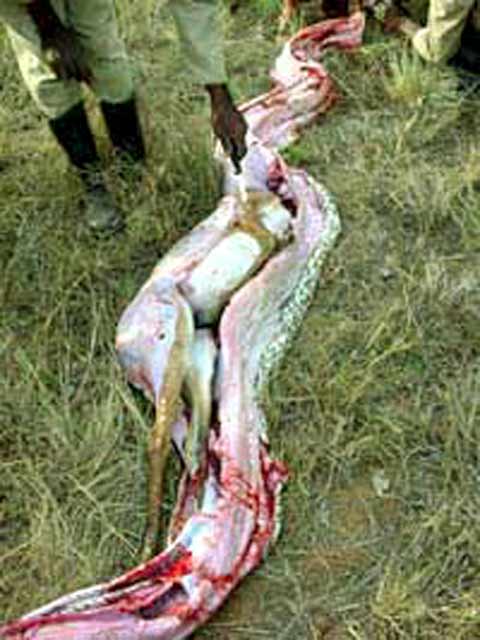This Boa Is No Moa
Why Snakes Are Feared...Saint George killed the last dragon, and he was called a hero for it. I've never seen a dragon, and I wish he would have left at least one. Saint Patrick made a name for himself by running the snakes out of Ireland, leaving the place vulnerable to rodent infestation. This business of making saints out of men who exterminate their fellow creatures has got to stop. All I'm saying is, it's starting to get a little lonely up here at the top of the food chain. - A Whitney Brown
And why was the snake so fat? Because he'd had a rather large meal...
Well, I warned you! Source: I don't know. I was forwarded these photos. If anyone knows their origin, please let me know. Thanks.
-------- Original Message -------- Hi dear, You know this picture is true. It happened late 1998, one of our own natives - we call them “MANGYAN” - was eaten by the giant snake which we call in our language (Tagalong) “SAWA”…
-------- Original Message -------- I just saw the picture you posted on your site. Actually, that picture of a python with a man sticking out from its belly was taken in the Philippines in 1998. That story made the headlines all over the country at that time, and it was featured on numerous tv documentaries here in the Philippines. When that unlucky man first disappeared, friends thought he was kidnapped by rebels (they actually called in the army to help in the search) but then later they discovered his awful fate. Below are some news excerpts relating the incident:
I hope this answered your question. Christian Dear Christian Thanks! Ruth -------- Original Message -------- Alan -------- Original Message -------- Hello there, I was cruising your site, and found those pictures of a snake that ate a man. I've seen many similar pictures, and have even heard of a certain scientist who studies how the human bodies are folded in the stomach. The part of the world that this occurs in is Asia, and the snakes are almost always Reticulated Pythons, not Boa Constrictors. Boa Constrictors grow to a maximum of 12 feet in length, and originate in South America. Reticulated pythons can grow up to 30 feet in length, making it the longest snake in the world. After checking out the pictures, the snake is definitely a Reticulated Python. =) For a bit more info: Snakes eating humans is something that happens in the US too. Check out Anapsid.org: there are newspaper stories of Burmese Pythons killing, and attempting to eat children and young teenagers. (Talk about irresponsible parents!...) Thought you'd like to know, Jacqui -------- Original Message -------- In response to the above email, the boa is the snake family in which the anaconda is a member and that is the biggest snake in the world. Also boas are not native to South America as stated, but are found all over North America, South America and Asia, India and parts of Africa, there are 30 or so different types of boas. Sorry to say what is stated was wrong on more than one point. The largest-known snake in the world is the anaconda, or Eunectes murinus, of South America. It holds the world's record for size with one specimen, encountered by petroleum geologists in eastern Columbia in 1944, measuring 37½ feet in length. Somewhere deep in the southern swamps do they grow bigger? According to Colonel Percy H Fawcett, a former British Army officer, surveyor and adventurer in the early 1900's. The anaconda lives in Central and tropical South America. It is a member of the boa family of snakes and is dark green in color with round markings. It is sometimes referred to as the "water boa." Because the anaconda's weight is usually supported by liquid, it can grow larger than snakes that make their homes in trees. The water-based anaconda often winds up drowning its victims (as they are pulled into the water) rather than suffocating them by constriction. Wayne The serpent crams itself with animal life that is often warm and vibrant, to prolong an existence in which we detect no joy and no emotion. - Alexander Skutch
Python Swallows Bangladeshi Tribal WomanRangamati - A python has swallowed a tribal women in Bangladesh's southeastern Chittagong Hill Tracts, police say. The python was later killed and the body of the woman was retrieved in Baghaichhari forest near Rangamati 350km from the capital Dhaka, a police officer said yesterday. The victim Basanti Tripura, 38 was taken off guard by the massive python which swallowed her slowly. A loud cry by her companion, also a woman, could not deter the python. The incident occurred on Tuesday when the two women went to the forest to collect fruits. Source: stuff.co.nz 22 November 2003
African Rock Python (Python Sebae)
The Rock python is Africa's largest snake; it eats mammals and birds. It lays up to 100 eggs about the size of a tennis ball in antbear (aardvark) holes, hollow tree or similar suitable places. The female coils herself around the eggs to protect them. The snake in this picture had eaten a full grown Impala ewe and, sadly, caught itself in an electric fence. Over four metres in length, this was a large specimen.
A view of the python's mouth. A python's bite is not venomous but would be very painful. When the python was skinned we found a full grown Impala ewe had just been swallowed. The python kills its prey by coiling itself around the animal and constricting it. When the animal is dead the python swallows it normally head first. Having swallowed its prey, the snake will find an abandoned burrow or hollow tree in which to hide and digest it's meal.
Source: bushveld.co.za -------- Original Message --------
Hey Ruth The pictures that were forwarded to you are actually from Sudan in the camp that my brother works. This I know for sure coz my brother even knew the guard so all this mambo jambo of it being from somewhere else is all lies. Mercy. Kenya Eric
For more on animals, including reptiles, crustaceans, arachnids, insects, fish, birds, pets, livestock, rodents, bears, primates, whales and Wellington's waterfront, click "Up"
below to take you back to the page on snakes. Clicking the "Up" button from there will take you to the Table of Contents for this Animals section. |
 Animals
Animals Animation
Animation Art of Playing Cards
Art of Playing Cards Drugs
Drugs Education
Education Environment
Environment Flying
Flying History
History Humour
Humour Immigration
Immigration Info/Tech
Info/Tech Intellectual/Entertaining
Intellectual/Entertaining Lifestyles
Lifestyles Men
Men Money/Politics/Law
Money/Politics/Law New Jersey
New Jersey Odds and Oddities
Odds and Oddities Older & Under
Older & Under Photography
Photography Prisons
Prisons Relationships
Relationships Science
Science Social/Cultural
Social/Cultural Terrorism
Terrorism Wellington
Wellington Working
Working Zero Return Investment
Zero Return Investment